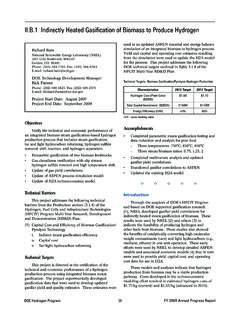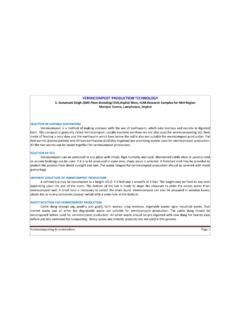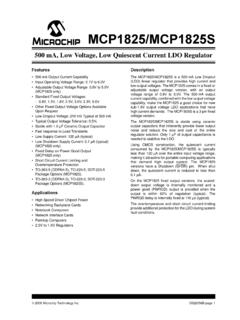Transcription of DOE Advanced Truck Technologies - Energy
1 1 Program Record Record #: 19006 Date: October 31, 2019 Title: Hydrogen Class 8 Long Haul Truck Targets Originator: Jason Marcinkoski Reviewed by: Fuel Cell Technologies and Vehicle Technologies Offices; Members of the 21st Century Truck Partnership; Strategic Analysis, Inc.; Argonne National Laboratory; Hydrogen Truck , Truck Component Suppliers, and Freight Industry Stakeholders; North American Council for Freight Efficiency; and Deputy Assistant Secretary for Transportation, EERE Approved by: Sunita Satyapal and David Howell Date: 12/12/2019 DOE Advanced Truck Technologies Subsection of the Electrified Powertrain Roadmap Technical Targets for Hydrogen-Fueled Long-Haul Tractor-Trailer Trucks 10/31/2019 Jason Marcinkoski,1 Ram Vijayagopal,2 Jesse Adams,1 Brian James,3 John Kopasz ,2 Rajesh Ahluwalia2 1 DOE Technical Targets for Advanced Truck Technologies A key activity within DOE s Office of Transportation within Energy Efficiency and Renewable Energy (EERE) is setting technology targets for achieving performance, durability, and cost required to be competitive with incumbent or other Advanced Technologies .
2 These targets guide early stage research and development (R&D) and serve as benchmarks for tracking technology . As electrified powertrains are becoming an important part of the Advanced Truck technology portfolio, DOE is setting detailed technical targets for both hydrogen-fueled fuel cell-powered trucks and battery electric trucks. Technical targets for Advanced Truck Technologies are developed with input from the 21st Century Truck Partnership (21 CTP) and will be included in new Electrified Powertrain Roadmaps to provide the technical foundation for research priorities, addressing one of four key research areas covered under 21 CTP. This document presents the technical targets for Class 8 long-haul tractor-trailer trucks powered by hydrogen and fuel cells.
3 Targets for battery electric tractor-trailer trucks will also be added to the Electrified Powertrain Roadmap. These hydrogen targets were developed for the long-haul use case, assuming trucks can be driven the maximum daily range (750 miles) between refueling. Other use cases will be considered for battery powered 1 Department of Energy (DOE) 2 Argonne National Laboratory 3 Strategic Analysis, Inc. 2 trucks that can be driven for 250 to 500 miles between charging events, where charging opportunities may exist at hubs, delivery points, or destinations. Future updates will take into account technological progress, additional analysis, and stakeholder feedback. The DOE offices within EERE s Transportation sector plan to expand these targets to include vocational and regional haul use cases within the class 4 to 8 range for various electrified and combustion-based powertrains.
4 A number of stakeholders including industry experts and the 21 CTP partners provided feedback during the target setting process. These targets were arrived at with industry input obtained through a Request for Information (RFI) and workshop feedback from relevant stakeholders on draft targets at the DOE H2@Scale4 End Use Applications: Fuel Cell Truck Powertrain R&D Activities and Target Review Workshop (DOE Fuel Cell Truck Powertrain Workshop)5 held in July 2018. Overall comments from the workshop stressed that the ultimate targets must be set such that fuel cell Technologies can be cost competitive with incumbent technology and meet the required vehicle performance metrics. 2 DOE Advanced Truck Technologies The Department of Energy (DOE) focuses on research and development (R&D) on a wide portfolio of transportation Technologies such as Advanced combustion, biofuels, battery electric vehicles, and fuel cell electric vehicles to support greater fuel economy, freight efficiency, and reduced emissions.
5 DOE and industry co-lead the 21 CTP to share information and coordinate efforts to advance commercially viable technology between the Truck industry and government entities. The 21 CTP includes the Department of Energy Vehicle Technologies Office, Fuel Cell Technologies Office; National Laboratories; industry; Army Ground Vehicle Systems Center (GVSC); and Department of Transportation (DOT) National Highway Traffic Safety, Federal Motor Carrier Safety, and Federal Highway Administrations (NHTSA, FMCSA, FHWA). The 21 CTP aims to foster technological innovation in improving the Energy efficiency and reducing the costs of the nation s economically vital Truck freight transportation system. The Partnership is developing new roadmap documents with additional details to provide the technical foundation for research priorities.
6 These targets will become part of the 21 CTP Electrified Powertrain Roadmap, one of four key research areas covered under the 21 CTP. The SuperTruck I program, which was launched by DOE in 2010 to improve heavy-duty freight efficiency by 50%, focused on internal combustion engine (ICE) technology as well as 4 H2@Scale is a concept that explores the potential for wide-scale hydrogen production and utilization in the United States to enable resiliency of the power generation and transmission sectors, while also aligning diverse multibillion dollar domestic industries, domestic competitiveness, and job creation. 5 H2@Scale End Use Applications: Fuel Cell Truck Powertrain R&D Activities and Target Review Workshop, Chicago, IL, July 30 31, 2018. -activities-and-target-review-workshop-h 2-scale-end-use 3 aerodynamics, and led to more than 20 fuel saving Technologies that have reached the commercial market.
7 SuperTruck II builds on the successful SuperTruck I program. In 2016, DOE funded the SuperTruck II program ($100M) to develop and demonstrate cost-effective Technologies that more than double the freight efficiency of Class 8 trucks compared to a 2009 baseline, and achieve 55% or greater engine brake thermal efficiency (demonstrated on a dynamometer at 65 mph). Background on the Domestic Truck Market The domestic market for Class 8 trucks is large and growing. Figures 1 and 2 below show annual Truck sales approaching 250,000 units per year (2015, 2017, and 2018), and sustained growth for Classes 4 to 7 trucks approaching 240,000 trucks per year in The long-haul use case is important as 40% of trucks travel between 250 and 750 average miles per workday (261 days per year), covering 70% of tractor trailer mileage (based on Vehicle Inventory and Use Survey7 [VIUS] annual miles traveled, see vehicle range assumption section below).
8 Figure 1. Class 8 Truck sales by manufacturer, 2012 2018 6 2016 Vehicle Technologies Market Report, Oak Ridge National Laboratory, , updated for 2018 7 2002 Vehicle Inventory and Use Survey (VIUS): 4 Figure 2. Class 4 7 Truck sales by manufacturer, 2012 2018 Role of Hydrogen and Fuel Cell Technologies Fuel cell technology is part of a portfolio of options for the advancement of zero emission vehicles (ZEV). In particular, fuel cells powered by hydrogen (H2) are emerging as an attractive technology platform for larger weight classes such as medium-duty and heavy-duty vehicles. Hydrogen can offer high gravimetric Energy storage density and fast refueling/recharging times, enabling longer driving range and higher vehicle utilization factors.
9 The high Energy storage density offered by these hydrogen fuel cell-powered vehicles provides sufficient vehicle range to meet at least 95% of the daily routes based on preliminary analysis of data collected from Census survey results and real-world drive cycle data Additionally, overnight hotel loads can use clean and efficient power produced from the same fuel cell used for primary traction power in conjunction with the powertrain s hybrid battery storage, eliminating the need for auxiliary power generation. While several vocational uses may be assessed, this document focuses on Class 8 long-haul tractor trailers. 8 Vehicle Inventory and Use Survey (VIUS): 5 3 Target Tables for Hydrogen Fueled Long-Haul Trucks Table 1. Technical System Targets: Class 8 Long-Haul Tractor-Trailers (updated 10/31/19) Characteristic Units Targets for Class 8 Tractor-Trailers Interim (2030) Ultimate9 Fuel Cell System Lifetime1,2 hours 25,000 30,000 Fuel Cell System Cost1, 3, 4 $/kW 80 60 Fuel Cell Efficiency (peak) % 68 72 Hydrogen Fill Rate kg H2/min 8 10 Storage System Cycle Life5 cycles 5,000 5,000 Pressurized Storage System Cycle Life6 cycles 11,000 11,000 Hydrogen Storage System Cost4, 7, 8 $/kWh ($/kg H2 stored) 9 (300) 8 (266) 1 The fuel cell system excludes hydrogen storage, power electronics, batteries, and electric drive.
10 2 The lifetime target is intended to cover the entire useful life of the vehicle. Fuel cell system lifetime is defined as hours of use with an appropriate duty cycle that considers real world driving conditions ( , not steady state operation). Corresponding vehicle lifetime range is 1M miles (Interim) and miles (Ultimate) based on an average speed of 40 mph. 3 Interim and ultimate cost targets assume 100,000 units per year production volumes (except where specified within parenthetical references). Note that meeting fuel cell and hydrogen storage component cost targets may require leveraging automotive production volumes to achieve the necessary economies of scale for cost competitiveness. Current (2019) heavy-duty vehicle fuel cell technology was estimated to cost ~$190/kW at 1,000 units per year manufacturing volume (Fuel Cell Systems Analysis, 2019 DOE Hydrogen and Fuel Cells Program Review Presentation, ).















